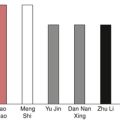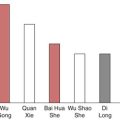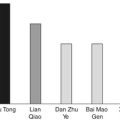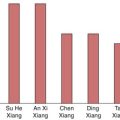Chapter Two. Herbs that release the Exterior
 |
1. What is Exterior syndrome? How should one treat Exterior syndrome? What are the characteristics of the herbs that release the Exterior?
The Lung is an important organ in Exterior syndrome because it governs the Exterior by dispersing the Defensive Qi to the superficial layer of the body. Moreover, Wind-Heat and Dryness can directly disturb the function of the Lung because they can invade the body through the nose, and not the superficial level.
The main symptoms can be divided into two groups. On the one hand, chills, fever and aversion to cold or wind are present. These are the manifestations in the superficial layer of the body caused by the conflict between pathogenic factors and the Defensive Qi. On the other hand, headache, general pain, thirst, blocked nose, cough and sore throat may be present; these are manifestations caused by disharmony of the circulation of the Qi and Blood in the Bladder meridian and dysfunction of the Lung-Qi.
The purpose of treatment is to expel the exogenous pathogenic factors, and to restore the normal functioning and harmony of all the organs, meridians, Qi and Blood. Methods that can stimulate or strengthen the function of the Defensive Qi or disperse the Lung-Qi and therefore eliminate the pathogenic factors are often used. Other methods, such as promoting Qi and Blood circulation, or regulating the Large Intestine in order to regulate the Lung-Qi, can also be used as assistant procedures in the whole treatment strategy.
Herbs that release the Exterior have the functions of expelling Wind-Cold or Wind-Heat. They are used in conditions where the pathogenic Wind-Cold or Wind-Heat invades the superficial layer of the body. They have the following properties.
Pungent or pungent and warm
Most of the herbs in this category possess a pungent property. As pungency has a dispersing capacity, the pungent herbs are able to activate Qi movement, open the pores and subcutaneous layer, connect the Exterior with the Interior, disperse the Lung-Qi, harmonize the Nutritive and Defensive systems and therefore expel Wind. Moreover, many of the herbs are pungent and warm in nature. Their functions of activating the Yang and Qi and opening the pores are represented by their induction of sweating in different degrees. Through sweating, Wind and other exogenous pathogenic factors can be eliminated from the superficial layer of the body, therefore stopping the progress of the disease in its primary stage.
Aromatic
Many of the herbs in this category are aromatic, which gives them the ability to open the orifices, penetrate turbidity, spread the pure Qi and transform Dampness. They are therefore used to treat headache, dizziness, nasal obstruction and loss of the sense of smell.
Light in weight and gentle in nature
Many herbs in this category are light in weight and gentle in nature. They mainly enter the Lung and the Bladder meridians, so they are suitable for treating the external pathogenic syndromes that mainly affect those layers and meridians. As wind characteristically attacks the upper body, which includes the head, the Lung, the Upper Jiao and the superficial layer of the body, these herbs are often used to treat symptoms such as headache, dizziness, nasal obstruction, runny nose, itchy and painful eyes, cough with or without production, sore throat and general body pain. Many are also used to treat allergies such as hay fever and asthma, as well as many kinds of skin diseases.
2. What precautions should be observed in the usage of herbs that release the Exterior?
First of all, since herbs that release the Exterior are pungent and their tendencies of action are ascending and dispersing, especially with the herbs that can cause sweating, overdose may disperse the Qi too much, consume the Yin of the body and cause other complications. In patients who are deficient in Yin or Qi owing to their constitution, chronic disease, stress or dietary habit, these herbs should be used with caution. Furthermore, as pungency also has the property of movement, these herbs should also be used with caution in bleeding conditions or in pregnancy.
Secondly, the dosage of herbs should be adjusted to suit the condition of the individual, the syndrome and the season. For elderly people, children, people with a weak constitution and for mild syndromes, in a gentle climate and in the summer, the dosage should be reduced. For adults with a strong constitution and for severe syndromes, in a cold winter or a cold place, the dosage should be increased. If sweating must be induced, the dosage is adjusted according to the syndrome. A mild sweat over the whole body is required. Heavy sweating must be avoided because it can only weaken the Qi and Yin.
In the third place, as eliminating Wind-Cold or Wind-Heat is not generally difficult, these herbs should not be used for a long period of time. A dosage of 3 days is recommended to treat Exterior syndrome. If the exogenous pathogenic factors have not been removed completely, then another 3-day dosage can be prescribed. With regard to herbs that may cause heavy sweating, the dosage and treatment course should be adjusted according to the reaction of the patient after each use.
3. Ma Huang ( Ephedrae herba)* and Gui Zhi ( Cinnamomi cassiae ramulus) can both expel Wind-Cold to treat Exterior Wind-Cold syndrome. What are the differences between their actions and characteristics? What are the cautions regarding their use?
Ma Huang and Gui Zhi can expel Wind-Cold and treat Exterior Wind-Cold syndrome. Compared with Gui Zhi, Ma Huang is stronger in inducing sweating and expelling Wind-Cold from the surface of the body. This is because Ma Huang is very pungent and warm, and its speed of movement and strength are stronger than Gui Zhi. When Wind-Cold attacks the body surface, the pores are closed by Cold, which is characteristically contracting, so the Defensive Qi is not able to spread over the surface of the body. In consequence, the patient feels chilly because the surface of the body is not warmed up by the Yang and Qi. The blockage of Defensive Qi inside may then produce Heat and the patient may have a fever. Because Cold initially injures the Yang-Qi in the Greater Yang ( Tai Yang) meridian, this stops the Qi circulating freely, and the patient feels pain and stiffness in the back of the body. Due to dysfunction of the dispersion of Lung-Qi, there are also cough and shortness of breath. Ma Huang enters the Lung meridian, disperses the Lung-Qi, enters the Bladder meridian, activates the Defensive Qi, opens the pores, causes sweating and expels Wind and Cold so that the Exterior can be released. This herb is considered as the strongest one for causing sweating. It is the first-line choice where Wind-Cold is severe and the patient has severe chills and fever without sweating, such as in upper respiratory tract infection, cold infections, influenza, acute bronchitis, pneumonia and asthma.
Gui Zhi can also treat Wind-Cold syndrome. Here the therapeutic result is achieved by warming the Blood, promoting Blood circulation, opening up the meridians and activating the Yang-Qi to expel Wind and Cold. Compared with Ma Huang, Gui Zhi is not so warm and pungent, but sweet. It enters the Heart meridian primarily, and the Lung and Bladder meridians secondarily. The warm nature of this herb can reduce Cold in the Blood. Pungency and warmth may also activate the Blood circulation and open up the meridians. The sweetness moderates the warmth and pungency so that the medicinal action may be balanced. As it enters the Lung and Bladder meridians, it can activate the Yang-Qi to eliminate Wind and Cold in the Exterior layer. When the pathogenic Cold is not so severe, the pores are not closed so tightly, which manifests as slight sweating or a milder cold sensation and less pain in the back of the body, Gui Zhi can be used alone. It is especially useful for patients with Exterior syndromes against the background of a Yang-deficient constitution, Bi syndrome or Cold in the Blood, such as in elderly people, patients with chronic bronchitis, pulmonary emphysema, rheumatism or Raynaud’s disease.
In clinical practice, Ma Huang and Gui Zhi are often used together to treat severe Wind-Cold syndrome, as they work on different aspects—for instance, the former enters the Qi level, the latter enters the Blood level; the former induces sweating and eliminates Wind-Cold by a short, quick and strong action, the latter promotes the Blood circulation, warms it, stops pain and activates the Yang-Qi in the Blood, thereby expelling Wind-Cold. When they are used together, the therapeutic effects are enhanced.
Although there are differences between Ma Huang and Gui Zhi, they both belong to quite warm and pungent herbs in the herbal group of expelling Wind-Cold. The dosage should be carefully managed. Age, constitution and the present state of health should also be considered. Generally speaking, after taking these herbs, if the patient does not sweat, the dose should be increased within the normal dosage range. If the patient becomes sweaty and the chills and fever are less severe, Ma Huang and Gui Zhi should not be used again. Some herbs with a gentler action can be substituted, such as Jing Jie ( Schizonepetae herba) and Fang Feng ( Saposhnikoviae radix). If, after a while, the chills and fever return, Ma Huang and Gui Zhi should be used again but in a smaller dosage as the Wind and Cold have already been partially expelled.
Moreover, as the tendency of action of these two herbs is upward and outward, in the following conditions they should not be used or used with caution: patients suffering from acute infection of the nose and throat where there is internal Heat or Heat due to Deficiency in the body, patients suffering from hypertension which indicates a tendency to Liver-Yang rising, or women suffering from menopausal syndrome with hot flushes and night sweats, and people with a Yang constitution or with heart disease, because these herbs can increase the contraction of the cardiac muscle and increase oxygen consumption, which makes the heart overwork.
4. What are the differences between the actions of Ma Huang ( Ephedrae herba)*, Zhi Ma Huang (honey-roasted Ephedrae herba) and Ma Huang Gen ( Ephedrae radix)?
Ma Huang is also called Sheng Ma Huang. ‘S heng’ means ‘raw’. Sheng Ma Huang is very pungent and warm. It is a very strong herb used to expel Wind and Cold to release Exterior Wind-Cold syndrome. As Sheng Ma Huang is pungent and hot, the dosage should be controlled and it should not be used over a long period of time. Overdose may cause heavy sweating, which injures the Yin, Body Fluids and Qi. It should be used with caution, especially in patients with a weak constitution and Deficiency syndrome. As its actions have an upward and outward tendency, Ma Huang should not be used or used with caution in cases of hypertension and heart disease.
Zhi Ma Huang is gentler in action compared with Sheng Ma Huang, because roasting with honey moderates the pungent taste. Zhi Ma Huang acquires the nature of honey, which is sweet and moistening, so its dispersing action is not as strong and quick as that of Sheng Ma Huang. It is often used to disperse the Lung-Qi and cause it to descend, to moisten the Lung and stop wheezing. In clinical practice, it is often used for treating asthma, bronchitis, pneumonia and acute nephritis.
Ma Huang Gen has completely different characteristics from both Sheng Ma Huang and Zhi Ma Huang. It is neutral, sweet and astringent, and enters the Lung meridian. It is excellent for stopping sweating. It can be used for treating spontaneous sweating and night sweating. It treats only the symptoms however, so it is often combined with other herbs that treat the cause of sweating. In addition, it should not be used in the syndrome of Phlegm accumulation or Exterior syndrome because it has an astringent property, which can retain Phlegm, close the pores and retain the pathogenic factors within the body.
5. What are the characteristic functions of Gui Zhi ( Cinnamomi cassiae ramulus)?
‘Twig of plants enters the limbs of human body’: such similes and allegories were often used in ancient times in Chinese medicine to explain the complicated links between the human and the natural environment. Gui Zhi is an example of this. This herb is the twig of the plant and has a warm, pungent and sweet nature. Besides expelling Wind and Cold to treat Exterior syndrome, Gui Zhi is often used to treat Bi syndrome. In this case, it can relieve pain and cold sensations in the affected limbs or joints. The therapeutic effects are achieved by warming and strengthening the Heart-Yang, promoting the Blood circulation, spreading the Yang-Qi and unblocking the meridians, especially in the limbs. This is why it is often used in Bi syndrome caused by blockage of the circulation of Qi and Blood by Wind, Dampness or Cold; examples are rheumatic fever, rheumatoid arthritis, rheumatic heart disease, Raynaud’s disease and the early and mid phases of vasculitis.
In chronic diseases, when internal Cold blocks the meridians, a small amount (about 10 m) of Gui Zhi alcohol drink is also a preferred formulation for daily use in the diet. Soaking 15 grams of Gui Zhi in a liter of alcohol (about 40% alcohol) made from cereals for 6 weeks yields Gui Zhi alcohol drink. Alcohol is pungent and warm, so is considered to have the functions of invigorating the Blood and unblocking the meridians. The functions of Gui Zhi and alcohol therefore enhance each other. It is commonly used for chronic Bi syndrome.
As Gui Zhi is pungent and warm, it should be used with caution if there is any deficiency of Yin with Empty-Fire or Liver-Yang rising in the syndrome or in the treatment of Heat-type Bi syndrome.
6. Jing Jie ( Schizonepetae herba) and Fang Feng ( Saposhnikoviae radix) are often used for Exterior Wind-Cold syndrome. What are the differences between using Ma Huang ( Ephedrae herba) and Gui Zhi ( Cinnamomi cassiae ramulus)?
Jing Jie and Fang Feng are both pungent and warm. However, they are far gentler than Ma Huang and Gui Zhi. They can expel Wind and Cold and are commonly used for mild Exterior Wind-Cold syndrome. In regions with temperate climates, where Wind and Cold do not close the pores tightly, they are more often applied than Ma Huang and Gui Zhi for cold infections, influenza, certain stages of infectious childhood diseases and some skin diseases in which Exterior syndromes are involved. Meanwhile, they are also often used with pungent-cold herbs in syndromes where Wind-Heat is mixed with Wind-Cold. The patient may have symptoms such as chills, fever, thirst, sore throat and general pain. These two herbs are more often used in combination with cold herbs than Ma Huang and Gui Zhi.
Comparing Jing Jie with Fang Feng, Jing Jie is lighter and more dispersing. It is pungent but not strong, slightly warm but not dry. It is especially good at expelling Wind, no matter whether it is Wind-Cold or Wind-Heat. Moreover, it can expel Wind from the Blood so is often used in skin disorders when there is itching caused by Wind invasion, for instance in eczema, urticaria and food allergy. It is also used for infectious childhood diseases with Exterior syndrome and skin eruptions, such as measles, rubella, scarlet fever, chickenpox and so on.
Although both herbs are gentle, they do have a pungent and warm nature, so both should be used with caution in patients without Wind invasion or in Yin deficiency with Empty-Heat.
7. What are the differences between the actions of Jing Jie ( Schizonepetae herba), Jing Jie Sui ( Schizonepetae flos), Chao Jin Jie (dry-fried Schizonepetae herba) and Jing Jie Tan (the charcoal of Schizonepetae herba)?
Generally speaking, Jing Jie Sui is more thin-pungent than Jing Jie as it is the bud, which is believed to be lighter in nature. It has a quicker and lighter action in expelling Wind. It is used at the very beginning of Wind-Cold syndrome or Wind-Heat syndrome.
Comparing raw with roasted Jing Jie, raw Jing Jie is more pungent. It is used for Exterior Wind-Cold syndrome when sweating is not present, which means that the pores are closed. It can open the pores, cause mild sweating and expel Wind and Cold. Roasted Jing Jie is less pungent because processing has reduced the taste. If the pores are open, sweating is present, or the patient has an aversion to wind instead of cold; this indicates that it is not necessary to open the pores, so roasted Jing Jie is then more suitable.
Jing Jie Tan is able to stop bleeding and it is used in bleeding conditions. When Jing Jie is roasted to charcoal, its pungent property is reduced, but an astringent property emerges. It can stabilize the Blood and stop bleeding. Meanwhile, it can also expel Wind and calm the Blood, therefore stopping bleeding.
8. Why is Xiang Ru ( Moslae herba) called Summer Ma Huang ( Ephedrae herba)?
‘ Xiang’ means ‘aroma’, ‘fragrance’; ‘ Ru’ means ‘gentle’. As the name explains, this herb is pungent and slightly warm with an aromatic smell. It enters the Spleen, Stomach and Lung meridians. Xiang Ru can, on the one hand, disperse Wind and Cold, induce sweating and release the Exterior; on the other hand, it transforms Dampness and harmonizes the Spleen and Stomach. The functions are similar to that of Ma Huang, but gentler. It is often used in summer when the weather is warm, the Wind-Cold is not so strong, the pores are not closed so tightly as in winter and the mild Wind-Cold attacks the body and causes an Exterior Wind-Cold syndrome. Meanwhile, Xiang Ru is used to treat abdominal pain, vomiting and diarrhea in summer, if overconsumption of cold drinks has injured the Stomach and Spleen, such as in acute gastritis.
Like Ma Huang, Xiang Ru can also direct the Lung-Qi to descend and relieve wheezing, transform Dampness and reduce edema, but its actions are too gentle, so it is rarely used alone.
Because Xiang Ru has similar actions to Ma Huang, and is more suitable for use in the summer, it is called ‘Summer Ma Huang’.
9. Xi Xin ( Asari herba)* is a commonly used herb for Exterior syndrome and Bi syndrome. What are its characteristics? What caution should be applied in clinical practice?
In Chinese, ‘ Xi’ means ‘fine’, ‘thin’; ‘ Xin’ means ‘pungent’. As described in the name, Xi Xin is a very pungent and hot herb with an aromatic smell. Its temperature and taste are as strong as Ma Huang ( Ephedrae herba)* and Gui Zhi ( Cinnamomi cassiae ramulus). However, Ma Huang and Gui Zhi enter the Bladder meridian and are often used to induce sweating. Xi Xin does not enter the Bladder meridian, but rather the Kidney meridian, which is why it has no function in inducing sweating. It is very effective in eliminating Cold and Wind in very deep layers of the body, such as the bones and tendons. Because of its strong aromatic smell, pungent taste and hot nature, it can easily penetrate into the deep layers. Meanwhile, entering the Kidney meridian makes it easy to reach the bones and tendons. It has the characteristic of searching out and eliminating Wind, Cold and Dampness, even if they are in the ‘corners’ or ‘chinks’ of the deep layers of the body, so it is often described as a ‘detector’ or ‘policeman’ in the body.
Because of this characteristic, it is often used in clinical practice in Exterior Wind-Cold syndromes if there is Kidney-Yang deficiency—for instance in elderly people, patients suffering from chronic diseases with internal Cold and patients with Bi syndrome. In these people, Wind and Cold may invade the body more deeply than usual, or the development can be very acute, the patient feels severe pain in the whole body and the pulse is deep and tight instead of superficial and tight.
Because of the same characteristic, this herb is also often used to stop pain and treat Bi syndrome when Wind, Cold and Dampness remain in the deep layers of the body and the Kidney-Yang is weak. In this case, patients not only have pain and a cold sensation in the affected joints, but also feel pain in the bones. They have difficulty with walking or cannot stand for long, and feel very stiff and painful in the tendons, especially in the lower body, feel cold in the extremities and are also afraid of cold. In winter or humid weather all these symptoms worsen.
Xi Xin can also be used for various stubborn pains, such as migraine, trigeminal neuralgia and toothache. This is because this herb is hot, has a very strong aromatic smell and pungent taste. It possesses a penetrating power, removes obstructions and its speed is very high. It can treat pain which is caused by stagnation of Qi and Blood.
Because of the same characteristic, it is also often used for opening the orifices. It enters the Lung meridian, and is effective in opening the nose, removing nasal obstruction, stopping a runny nose, transforming Dampness and pus and improving the sense of smell. In clinical practice, it is often used for treating sinusitis, acute and chronic rhinitis and allergic rhinitis.
The side-effects of Xi Xin can be shown in clinical practice when it is used improperly. Because it is very hot and pungent, it easily injures the Yin, Blood and Body Fluids and weakens the Qi. It should not be used, or used with caution, in patients suffering from Bi syndrome or Exterior Wind-Cold syndrome complicated with Excessive-Heat or Empty-Heat, or weakness of Yin, Blood and Body Fluids.
The dosage of Xi Xin should also be controlled carefully within the range of 1–3 grams per day for crude herbs. If the concentrated herbal powder is used, this dosage should be reduced to 0.1–0.5 grams per day. Overdose may cause numbness in the throat and tongue, stifling in the chest and even death due to paralysis of the diaphragm. Modern research indicates that this herb should be used with particular caution in patients with renal problems as it has nephrotoxic effects. Moreover it is incompatible with Li Lu ( Veratri nigri radix et rhizoma).
10. Sheng Jiang ( Zingiberis rhizoma recens), Sheng Jiang Zhi ( Zingiberis rhizoma recens succus), Wei Jiang (roasted Zingiberis rhizoma recens) and Sheng Jiang Pi ( Zingiberis rhizoma recens cortex) are all products of the same herb. What are the differences between their actions?
Sheng Jiang is pungent and slightly warm, and enters the Lung, Spleen and Stomach meridians. It can disperse Cold and Wind, but its action is not strong. It is used only for mild Exterior Wind-Cold syndrome. However, as it enters the Spleen and Stomach meridians, it has some other excellent functions. It can warm the Middle Jiao, soothe the Stomach-Qi and alleviate nausea and vomiting. Because it is so effective in stopping vomiting, it is considered as the first-line choice for treating nausea. This herb is also a good choice if a patient suffers from a Wind-Cold syndrome, has fever, chills, blocked nose and headache, and in the meantime the Stomach-Qi fails to descend, so nausea and vomiting are present—such as in abdominal influenza or acute gastritis.
As Sheng Jiang enters the Lung and Stomach meridians, and is warm and pungent, it can dissolve Phlegm in the Lung and stop a cough. It can be used in patients with chronic bronchitis or asthma and in the meantime who are being attacked by Wind-Cold once more. Sheng Jiang is also suitable for conditions of water accumulation in the Stomach when overconsumption of cold drinks has injured the Stomach and Spleen. The manifestations include fullness in the upper abdomen, poor appetite, nausea and vomiting, such as in acute gastritis.
Sheng Jiang can also reduce the toxicity of Ban Xia ( Pinelliae rhizoma) so it is often used to process Ban Xia. After processing, Ban Xia is then called Jiang Ban Xia or Zhi Ban Xia (processed Pinelliae rhizoma).
In Chinese kitchens, Sheng Jiang is often used not only for the taste of the dishes, but also for promoting digestion. It soothes the Stomach-Qi, improves the appetite, and reduces or prevents the toxicity of seafood if it is not fresh. The warm nature of Sheng Jiang can also reduce the cold nature of seafood, so the latter is more easily digested and healthy.
If Sheng Jiang is smashed and the juice squeezed out, the result is Sheng Jiang Zhi. This is pungent and slightly warm. Its function is more or less the same as Sheng Jiang, but stronger and quicker. It is therefore used in acute conditions, such as severe nausea, vomiting and coma due to Phlegm covering the orifices. In this situation, the normal dose is 3–10 drops of Sheng Jiang Zhi in warm water.
If Sheng Jiang is cleaned with water, then covered with a moistened soft paper and placed near the fireplace, but not above the fire, after a while the paper turns brown and the Sheng Jiang is roasted; it is then called Wei Jiang. It is warm and pungent, but after this processing its pungent taste and the dispersing function are weaker than those of Sheng Jiang and Sheng Jiang Zhi. Meanwhile, the temperature has been increased and the harmonizing function is obtained. It is good at warming the Spleen and Stomach and is used for nausea, vomiting, abdominal pain and diarrhea caused by Cold invasion of the Middle Jiao.
Sheng Jiang Pi is the peel of Sheng Jiang. It is the only product of Jiang that is cold in temperature. It is also pungent and enters the Spleen meridian. It can regulate water metabolism, promote urination and leach out Dampness. As the herb is quite gentle, it is used especially for edema in pregnant women. For severe edema, it must be used with other herbs that have stronger actions.
11. Qiang Huo ( Notopterygii rhizoma), Bai Zhi ( Angelicae dahuricae radix), Chuan Xiong ( Chuanxiong rhizoma) and Gao Ben ( Ligustici sinensis radix) are often used for treating headache. What are the differences between their actions?
Headache is a symptom as well as a syndrome. Besides the treatment of the causes according to the differentiation of syndromes, some specific herbs that are very effective for alleviating headache as a symptom are often used in treatment.
All of these four herbs can alleviate headache. They are warm, pungent and aromatic. Warmth and pungency can activate Qi movement, pungency and aroma can penetrate the accumulation of Dampness, Qi and Blood, therefore dispersing the accumulation. Warmth and pungency can also dry Dampness and unblock the meridians, so relieving pain. They are very effective in the treatment of headache caused by invasion of exogenous pathogenic factors and disturbance of the Qi movement and Blood circulation. They can also be used for headache due to stagnation of Qi and Blood in the dysfunction of internal organs.
The four herbs also have their individual characteristics in their action because they enter different meridians. Qiang Huo enters the Bladder meridian and treats pain in the occiput especially; Bai Zhi enters the Stomach meridian and is especially effective for relieving pain in the forehead; Chuan Xiong enters the San Jiao and Gall Bladder meridians and treats headache on the sides of the head; Gao Ben enters the Bladder meridian, so can reach the top of the head and alleviate the pain there.
As many meridians pass through the head, headache is often caused by blockage of one or more meridians, such as in migraine, headache due to stress, spondylosis and sinusitis. These herbs are often used together according to the location of the pain. Since they focus on the symptoms rather than the syndrome, they should be used as only one part of the complete treatment of the syndrome.
12. Ge Gen ( Puerariae radix), Sheng Ma ( Cimicifugae rhizoma) and Chai Hu ( Bupleuri radix) are all commonly used herbs for dispersing and lifting the Yang-Qi. What are the differences between them?
Ge Gen, Sheng Ma and Chai Hu all have the functions of releasing the Exterior, and dispersing and lifting the Yang-Qi. However, there are some differences between their actions because they enter different meridians and work in different regions of the body.
Ge Gen enters the Spleen and Stomach meridians. It is pungent, but sweet and neutral. Pungency can disperse the Yang-Qi, but the sweet and neutral properties make the dispersing action gentler. Generally speaking, Ge Gen is gentle and light in its action. It can gently disperse and lift the pure Yang and Qi, especially from the Spleen and Stomach. It is used for Exterior syndromes when the exogenous pathogenic factors have passed through the superficial layer of the body and entered the subcutaneous region and the muscles, which are considered to be governed by the Spleen and Stomach. The corresponding manifestations are rashes and fever. Ge Gen can gently disperse the Qi from this region and expel the exogenous pathogenic factors to vent rashes. It is used to hasten recovery from measles when the expression of the rash is incomplete.
Ge Gen can treat diarrhea due to weakness of the Spleen-Qi and sinking of the Yang. In this situation, dry-fried Ge Gen is the preferred choice because a warm property has been acquired from the processing, so it is more effective for lifting the Yang and Qi in the Middle Jiao. It can treat diarrhea due to Damp-Heat in the intestines or due to sunken Spleen-Yang when it is used with other herbs to treat the cause of the disorder.
As Ge Gen enters the Stomach meridian of foot Bright Yang ( Yang Ming) and lifts the pure Yang-Qi, it can treat Wasting and Thirsty syndrome, which is termed diabetes in Western medicine. This disease is caused by Dryness in the Stomach, while the Spleen-Qi is too weak to spread the Body Fluids. The patient may suffer from excessive thirst, and a dry mouth and throat. Ge Gen is able to lift the Yang-Qi from the Middle Jiao to assist the spreading of the Body Fluids and alleviate Dryness.
Sheng Ma enters the Spleen, Stomach, Large Intestine and Lung meridians. It is sweet, pungent and slightly cold. Compared with Ge Gen, it has the particular effect of clearing Heat and dispersing it from these meridians. It disperses Wind-Heat and treats headache in the forehead where the Bright Yang meridian passes through; it also clears and disperses Heat in the Stomach, Large Intestine and Spleen, and treats ulcers in the cheeks, tongue and gums. Compared with Ge Gen, it has a stronger action of lifting the Yang-Qi in cases of prolapse of the stomach, uterus and rectum, and diarrhea. As Sheng Ma is slightly cold in nature, it should be used together with some warm herbs to tonify the Spleen if the Spleen-Qi is weak.
Chai Hu enters the Liver and Gall Bladder meridians. It is pungent, neutral and aromatic. It possesses a dispersing and ascending capability. Chai Hu is particularly effective in spreading the Qi in the Lesser Yang (Shao Yang) meridians. It can disperse Wind-Heat if the exogenous pathogenic factors stay at the Lesser Yang level. The symptoms of them are alternating chills and fever, a dry throat and bitter taste in the mouth, and fullness in the chest and hypochondriac region. As Chai Hu enters the Liver and Gall Bladder meridians, it can spread the Liver-Qi effectively. It is the most commonly used herb to treat stress, irritability, resentment, depression and other mental and emotional disorders due to stagnation of the Liver-Qi.
Chai Hu has similar functions to Sheng Ma, like lifting sunken Yang-Qi to treat prolapse of internal organs and tissues. The two are often used together to enhance the effect of each other.
These three herbs should be used with caution in clinical practice. As they all have dispersing and ascending abilities, the dosages should be well controlled. According to both theory and experience, small amounts of herbs may lead to a dispersing action whereas large amounts can actually lead to a descending and purging action, so the dosages of the three herbs should be less in their usual dosage than other herbs. If the concentrated herbal powder is prescribed, 0.3–0.5 grams is the daily dosage. In addition, these herbs should be used with caution in patients suffering from uprising of Yang or flaring up of Fire.
13. Bai Zhi ( Angelicae dahuricae radix), Xin Yi ( Magnoliae flos) and Cang Er Zi ( Xanthii fructus) are often used together to treat rhinitis and sinusitis. What are the differences between them?
All of these three herbs enter the Lung meridian. They are warm and pungent, expel Wind-Cold, open the obstruction of the nose and stop pain; they are often prescribed together.
Bai Zhi enters not only the Lung meridian, but also the Stomach meridian. It is pungent with a rich aromatic smell, and so possesses a strongly ascending property. It is often used to treat disorders in the area of the head through which the Bright Yang meridians pass. This is why this herb is often used for rhinitis and sinusitis. Moreover, it possesses a strong aromatic smell, which is believed to be able to penetrate turbidity, transform Phlegm and pus, dry Dampness and reduce swelling. It is appropriate for sinusitis, especially if there is a green nasal discharge that has a foul smell and the patient feels a sensation of fullness in the sinuses. Meanwhile, some herbs which are bitter and cold in nature should also be used simultaneously to clear Heat and dry Dampness.
Xin Yi is pungent, warm and aromatic, but more moderate in action and lighter in nature than Bai Zhi. It is particularly effective for opening the nose, and gently dispersing and lifting the pure Qi in the facial area. It is often used in cases of nasal obstruction, and loss of, or reduced, sense of smell, such as in atrophic rhinitis, pachyntic rhinitis and allergic rhinitis. Xin Yi is able to lift the pure Yang to the top of the head, so it can stop pain and can be used for ethmoidal sinusitis, frontal sinusitis and sphenoiditis.
Cang Er Zi is bitter and warm and enters the Lung meridian. It is effective for drying Dampness. Its warm and bitter nature gives it a spreading ability, so it can spread the Qi and expel Wind. It has a similar function to that of Bai Zhi in transforming Dampness and treating profuse nasal discharge. However, its aromatic smell is less strong than that of Bai Zhi, so it has a lesser ability to transform turbidity and pus. However, it is used particularly when there are large amounts of clear nasal discharge and itchiness of the nasal passage, which is considered as Wind invasion.
Cang Er Zi also has a wider application range than Bai Zhi and Xin Yi. It can treat headache due to Wind-Dampness. It has a drying nature but is not harsh, so it is also used in some skin diseases where the skin lesions are characterized by itching and weeping.
As in rhinitis or sinusitis, these symptoms often exist simultaneously with nasal obstruction, a reduced sense of smell, a feeling of fullness in the nose or sinuses, an itchy nasal passage, profuse discharge and headache, so the three herbs are often used together.
14. Bo He ( Menthae herba), Chan Tui ( Cicadae periostracum), Niu Bang Zi ( Arctii fructus), Jiang Can ( Bombyx batrycatus) and Jing Jie ( Schizonepetae herba) are able to expel Wind and alleviate itching, and are commonly used for different skin diseases. What are the differences between them?
Itching, in skin disorders, is considered in TCM to be an invasion of Wind in the Exterior or the Blood level. The Lung is believed to be the directly corresponding organ in skin disorders as it governs the superficial layer of the body. Any factor which directly or indirectly disturbs the function of the Lung may induce or aggravate skin disorders.
All of these five herbs enter the Lung meridian. Only Jing Jie is pungent and slightly warm; the rest are pungent and cold. Apart from the action of releasing the Exterior, they can expel Wind and alleviate itching, so are often used in various itchy skin disorders, such as eczema, urticaria and different types of dermatitis and pruritus. Sometimes the itching is so pronounced that these herbs have to be used together. However, these herbs all have their own characteristics and could be used in different types of itching.
Bo He is pungent and cold and enters the Lung and Liver meridians. It not only treats itchy rashes due to Wind-Heat in the Exterior, but also clears Heat and benefits the throat. It is particularly appropriate for use in the acute phase of a chronic skin disorder, when Wind-Heat invades the body, and fever, chills, itching and a dry throat are present. It can also be used for infectious diseases in children, which are often accompanied by skin manifestations due to Heat in the Lung and Liver meridians (e.g. rubella, measles, chickenpox and scarlet fever).
Chan Tui is the sloughed skin of the cicada. It is very light in weight, salty and slightly cold. Its light, ascending property gives it a gentle dispersing action, and it can expel Wind-Heat in the Lung. Saltiness enters the Blood, and saltiness and Cold may clear Heat in the Blood and extinguish Wind, sweetness and Cold can generate the Body Fluids, moisten Dryness and calm Wind, while the slough (skin), enters the skin of humans according to the concept of Chinese herbal medicine. Therefore, Chan Tui can alleviate itching caused by external Wind and treat itchy skin diseases such as urticaria, eczema, pruritus and neurodermatitis.
Chan Tui also enters the Liver meridian. As saltiness enters the Blood and Cold can clear Heat, saltiness and Cold may cool the Blood and clear Heat in the Heart and Liver, calm the Mind and control spasm. It is effective for treating irritability, restless sleep, and even convulsions due to Heat in the Liver meridian in children. If a child suffers from skin disease and there is Heat in the Liver, Chan Tui is a good choice. It is also an appropriate choice in adults when skin disorders worsen under stress and in elderly people when there is deficiency of Body Fluids and Dryness of the Blood, which generate Wind and cause itching over all the body, especially during sleep.
Niu Bang Zi is pungent, bitter and cold, and enters the Spleen and Stomach meridians. Pungency can disperse Wind; bitterness and Cold can drain Heat. It is rich in plant oils so can moisten the intestines and promote bowel movement. It is the coldest of these herbs and is able to remove Heat-toxin. For skin problems, this herb is more appropriate for red skin lesions which are not only itchy, but also slightly painful with a burning sensation, and where the skin problem worsens when there is also constipation, which suggests that Heat from the Bright Yang meridians may be affecting the Lung.
Jiang Can is pungent, salty and neutral. It enters the Lung and Liver meridians. Pungency can disperse Wind so it is good at relieving itching in skin conditions. Jiang Can is able to dissolve Phlegm and also calms the Mind. It is preferred for treating patients who have fever, itchy skin rashes, irritability and restless sleep—for instance in some infectious childhood diseases.
Jing Jie is an excellent herb in TCM for treating disorders caused by Wind. It is a gentle herb, warm but without a drying property and is particularly effective for expelling Wind. Jing Jie is pungent, slightly warm and enters the Lung and Liver meridians. It can disperse Wind-Heat from the Blood level to stop itching. It can be chosen for different kinds of skin disease due to Wind-Heat in the Lung or Heat in the Blood. It is often used together with Jin Yin Hua ( Lonicerae flos) and Lian Qiao ( Forsythiae fructus) for red skin lesions. Its powder can be applied topically to stop itching.
15. Bo He ( Menthae herba), Ju Hua ( Chrysanthemi indici flos), Sang Ye ( Mori folium) and Chai Hu ( Bupleuri radix) have similar functions of expelling and dispersing Wind-Heat in the Upper Jiao. What are the differences between them?
All of these four herbs possess light, ascending and dispersing properties. They are used to expel Wind, disperse Heat and treat Exterior Wind-Heat syndrome.
Of these herbs, Bo He is the coldest. It primarily enters the Lung meridian and secondarily enters the Liver meridian. Pungency may disperse Heat; coolness may reduce Heat; lightness in weight and nature can disperse Heat in the Upper Jiao and the aromatic smell can open the orifices. Thus Bo He is excellent for Exterior Wind-Heat syndrome when the head is affected—for instance in patients suffering from headache, sore and red eyes and a sore throat. These complaints are often seen in cold infections, bronchitis, sinusitis, influenza and pruritic rash in infectious childhood diseases. Apart from this, because Bo He enters the Liver meridian it is effective for spreading the Liver-Qi and clearing Heat and so is used for Liver-Qi stagnation with flaring up of Liver-Heat. The manifestations of this condition include headache, dizziness, poor concentration, a bitter taste in the mouth and a feeling of fullness in the chest and hypochondrium. These symptoms can be seen in hypertension, hepatitis, premenstrual syndrome, depression and other mental disorders.
Ju Hua is sweet, bitter and slightly cold, and enters the Lung, Liver, Kidney and Gall Bladder meridians. Sweetness and Cold can generate Yin; bitterness and Cold can reduce Heat. As it particularly enters the Liver meridian, can calm the Liver and benefit the eyes, it is used for treating acute inflammation of the eyes. It can also be used for dizziness, blurred vision, dryness of the eyes due to deficiency of Liver-Yin and Kidney-Yin, stagnation of Liver-Qi and uprising of Liver-Yang, and in conditions such as eye strain, hypertension, glaucoma and retinal bleeding.
Sang Ye is bitter, sweet and cold and it enters the Lung meridian. It is gentle and light, and possesses both dispersing and ascending properties. It can disperse Wind and Heat as it is collected in late autumn (the season of the Lung according to the Five Elements theory) and after frost, so it receives its cool property from nature. Sweetness and coolness may generate Body Fluids and clear Heat which lasts from summer. It is used for cough without production, and dryness of the throat that is caused by Dry-Heat injuring the Lung-Yin. This herb is also good for treating those symptoms that are present after febrile disease when the Heat has disappeared but the Yin has been consumed—for instance after pneumonia or acute bronchitis.
Because Sang Ye also enters the Liver meridian, it can be used for treating cough caused by Liver-Fire attacking the Lung. It is good at clearing Lung-Fire and pacifying the Liver. It is particularly suitable for treating paroxysmal cough without production, thirst, and a dry mouth and throat, and concomitant depression, hypochondriac distension and irritability, such as seen in chronic bronchitis, pulmonary tuberculosis and diabetes.
Chai Hu is pungent, bitter and neutral; it enters the Liver and Gall Bladder meridians. Pungency and lightness lead to ascending and spreading actions, so it is particularly effective for spreading the Liver-Qi and lifting the clear Qi at the Lesser Yang level. Bitterness may lead the Qi or Heat downwards, which is why it is very often used for venting Wind-Heat in the Upper Jiao and at the Lesser Yang level, although it is not cold. It can treat conditions with alternating chills and fever, a dry throat, a bitter taste in the mouth, dizziness and irritability. Since the Liver is an important organ in the Qi movement of the whole body, stagnation of the Liver-Qi may lead to disturbance of Qi in the whole body and bring about emotional and physical disorders such as tightness in the chest and hypochondria, irritability, depression, irregular menstruation, heartburn, nausea, vomiting and reduced appetite. Chai Hu is the most important and commonly used herb for spreading the Liver-Qi. In clinical practice, it is used for treating hepatitis, cholecystitis, cholelithiasis, gastritis, gastric ulcer, gastroneurosis, asthma, depression, neurosis, premenstrual syndrome and other mental disorders.
16. How many kinds of Ju Hua ( Chrysanthemi indici flos) are used for medical purposes and how does one choose the correct one in practice?
There are several kinds of Ju Hua and Ju Hua products that have various properties according to the growing habitat, the color and the processing procedure. Huang Ju Hua, the yellow flower, is sometimes called Hang Ju Hua, as it comes from Hang Zhou. Bai Ju Hua, the white flower, is also called Gan Ju Hua, which means sweet Ju Hua. It is also sometimes called Chu Ju Hua because the white Ju Hua growing in Chu county is considered to have the best quality. There is also. Ye Ju Hua, the wild Ju Hua, is a third kind of Ju Hua also used in clinical practice. Generally speaking, Ju Hua is sweet, bitter and slightly cold. It has the functions of clearing Heat in the Upper Jiao, pacifying the Liver and benefiting the eyes.
Huang Ju Hua especially enters the Lung meridian. It is more effective for expelling Wind-Heat in the Upper Jiao and is often used in cold infections, feverish sensations in the head and headache. It can also be used for acute infection of the eyes, such as acute conjunctivitis, which in TCM is considered to be Wind-Heat disturbing the Upper Jiao. In this condition, as well as oral use, the steam from Ju Hua decoction can be used for painful and itchy eyes. The method is simple: pour the hot decoction into a glass, and bring the affected eye close to the glass for 2–3 minutes. Care should be taken not to burn the eye. Moreover, the cool decoction can be used externally to wash the affected eye.
Ye Ju Hua is bitter and neutral. It can reduce Heat and remove Heat-toxin. It is used for all types of boils, furuncles and carbuncles with localized erythema, swelling, heat and pain. This herb can also be used topically: the smashed fresh Ju Hua can be applied to the affected region as a compress to reduce swelling and pain—for instance in mumps.
17. Besides treating cold infections or influenza, are there other uses for the herbs in the category of releasing the Exterior?
Cold infections are often not treated and most people recover in 1 or 2 weeks without medical intervention. It may take longer to recover from influenza. Herbs that release the Exterior are often used in cold or influenza infections as they can alleviate the symptoms and shorten the duration of morbidity. This is especially useful and important for elderly people, children, patients with chronic diseases and people with a weak constitution.
Herbs in the category of releasing the Exterior can be used, in clinical practice, in many other conditions if the disorders link with the superficial layer of the body, or if the disorders have the same pathological changes in the body as those of the Exterior syndromes. Examples include the following.
Alleviation of pain
As pungency and warmth have dispersing and moving properties, most of these herbs that are warm and pungent can disperse Wind, Cold and Dampness. They are often used for Bi syndrome due to invasion of exogenous pathogenic Wind, Dampness and Cold. The commonly used herbs are Gui Zhi ( Cinnamomi cassiae ramulus), Qiang Huo ( Notopterygii rhizoma), Qin Jiao ( Gentianae macrophyllae radix), Xi Xin ( Asari herba)* and Fang Feng ( Saposhnikoviae radix). Some herbs are very effective for treating certain kinds of pain. For example, Xi Xin is very good for treating toothache; Bai Zhi ( Angelicae dahuricae radix) is effective for treating headache due to sinusitis; Qiang Huo can relax the muscles in the neck and treat pain in the occiput, neck and upper back; Zi Su Ye ( Perillae folium) can alleviate abdominal pain in abdominal influenza; Gui Zhi can warm the Blood, promote Blood circulation and relieve general pain.
Dispersal of the Lung-Qi and treatment of asthma
Most of the herbs that release the Exterior enter the Lung meridian. Because the Lung governs the superficial level of the body, dispersal of the Lung-Qi may assist in expelling Exterior pathogenic factors. In addition, these herbs are also often used to treat asthma, which is caused by dysfunction of dispersing and descending of the Lung-Qi. The commonly used herbs are Ma Huang ( Ephedrae herba)*, Xi Xin ( Asari herba)* and Sheng Jiang ( Zingiberis rhizoma recens).
Regulation of water metabolism and treatment of edema
As most of the herbs that release the Exterior enter the Lung and Bladder meridians, which are important in water metabolism, they can also disperse the Lung-Qi, regulate the water passages and treat edema due to dysfunction of the Lung. For instance, Ma Huang ( Ephedrae herba)* and Fang Feng ( Saposhnikoviae radix) can be used in Wind-Water syndrome. In this syndrome, the patient suddenly has edema on the face as a result of Wind disturbing the Lung and blocking the upper part of the water passage. This can be seen in acute nephritis, premenstrual syndrome and menopausal syndrome.
Expelling of Wind, clearing of Heat and treatment of skin diseases
Exterior syndromes are located on the surface of the body, where skin diseases are also located. The pungent and cold herbs can disperse Wind to relieve itching; these include Chan Tui ( Cicadae periostracum), Jing Jie ( Schizonepetae herba), Bo He ( Menthae herba), Niu Bang Zi ( Arctii fructus) and Fang Feng ( Saposhnikoviae radix). Some cold herbs such as Ju Hua ( Chrysanthemi indici flos), Niu Bang Zi ( Arctii fructus) and Bo He ( Menthae herba) may reduce Heat and calm reddish skin lesions. Herbs entering the Lung meridian may regulate the function of the Lung to regulate the condition of the skin.
Treatment of infection or allergic reactions of the ears, nose, throat and eyes
The pungent and cold herbs that expel Wind-Heat are light in weight and nature. They enter the Upper Jiao and can disperse Wind-Heat in the head, so can be used for acute or chronic infections and allergic rhinitis as well as some types of food allergies, which in TCM are considered to be Wind-Heat disturbance in the Upper Jiao. Herbs that can be used include Bo He, Ju Hua, Niu Bang Zi, Xin Yi ( Magnoliae flos), Fang Feng and Jing Jie.
Treatment of initial stages of infectious childhood diseases
Many infectious childhood diseases, especially those with skin rashes such as chickenpox, scarlet fever and rubella, belong to the category of Wind-Heat attacking the Lung. The treatment in the initial stage is focused on expelling Wind, clearing Heat and regulating the Lung-Qi. Herbs such as Bo He, Ju Hua, Chan Tui and Niu Bang Zi are often used.
Treatment of acute infections, infectious diseases or inflammation
For some acute infections, such as pneumonia or acute bronchitis, if caused by a virus then treatment with antibiotics is ineffective because the fever is still there and the infection continues. In such conditions, herbs that expel Wind-Heat combined with other herbs can bring a better result. In TCM there is a saying: no matter how high the fever is, if there is one percent chill, there is one percent Exterior syndrome. Antibiotics are considered in TCM to be bitter and cold substances; therefore their action tendency is downward and they can only clear the Heat. This action may bring about the side-effects of constrained Fire, so the result of treatment is not completely satisfactory. Herbs used in this condition not only clear Heat but also disperse it and at the same time expel other exogenous pathogenic factors. They match the pathogenic changes and the nature of Heat so are better in reducing fever and controlling the infections.
Comparisons of strength and temperature in herbs that release the Exterior
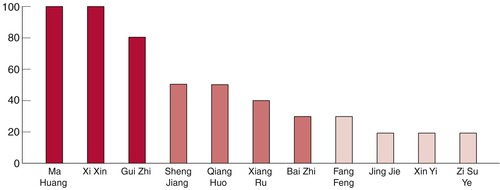 |
| Fig. 2.1. |
| Comparison of the temperature of the warm herbs. Ma Huang ( Ephedrae herba)*, Xi Xin ( Asari herba)*, Gui Zhi ( Cinnamomi cassiae ramulus), Sheng Jiang ( Zingiberis rhizoma recens), Qiang Huo ( Notopterygii rhizoma), Xiang Ru ( Moslae herba), Bai Zhi ( Angelicae dahuricae radix), Fang Feng ( Saposhnikoviae radix), Jing Jie ( Schizonepetae herba), Xin Yi ( Magnoliae flos), Zi Su Ye ( Perillae folium). |
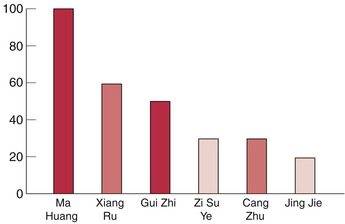 |
| Fig. 2.2. |
| Comparison of the herbs that induce sweating. Ma Huang ( Ephedrae herba)*, Xiang Ru ( Moslae herba), Gui Zhi ( Cinnamomi cassiae ramulus), Zi Su Ye ( Perillae folium), Cang Zhu ( Atractylodis rhizoma), Jing Jie ( Schizonepetae herba). |
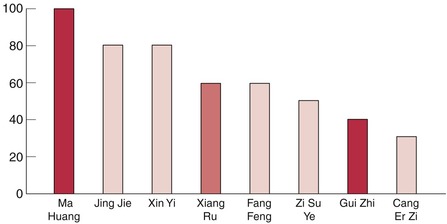 |
| Fig. 2.3. |
| Comparison of the light and dispersing features of the warm herbs. Ma Huang ( Ephedrae herba)*, Jing Jie ( Schizonepetae herba), Xin Yi ( Magnoliae flos), Xiang Ru ( Moslae herba), Fang Feng ( Saposhnikoviae radix), Zi Su Ye ( Perillae folium), Gui Zhi ( Cinnamomi cassiae ramulus), Cang Er Zi ( Xanthii fructus). |
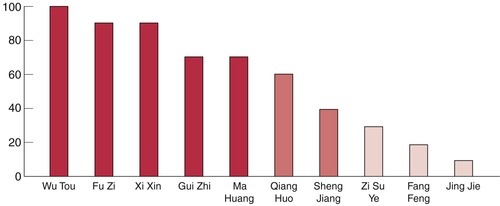 |
| Fig. 2.4. |
| Comparison of the herbs that expel exogenous Cold. Wu Tou ( Aconiti radix)*, Fu Zi ( Aconiti radix lateralis preparata)*, Xi Xin ( Asari herba)*, Gui Zhi ( Cinnamomi cassiae ramulus), Ma Huang ( Ephedrae herba)*, Qiang Huo ( Notopterygii rhizoma), Sheng Jiang ( Zingiberis rhizoma recens), Zi Su Ye ( Perillae folium), Fang Feng ( Saposhnikoviae radix), Jing Jie ( Schizonepetae herba). |
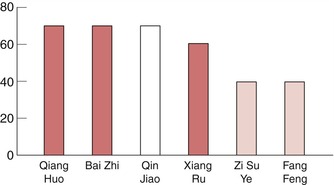 |
| Fig. 2.5. |
| Comparison of the herbs that expel exogenous Dampness. Qiang Huo ( Notopterygii rhizoma), Bai Zhi ( Angelicae dahuricae radix), Qin Jiao ( Gentianae macrophyllae radix), Xiang Ru ( Moslae herba), Zi Su Ye ( Perillae folium), Fang Feng ( Saposhnikoviae radix). |
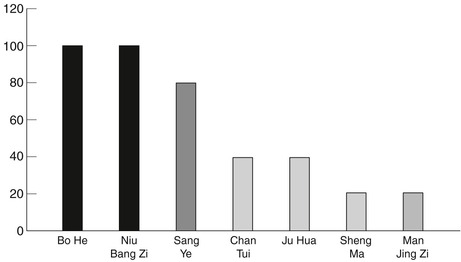 |
| Fig. 2.6. |
| Comparison of the temperature of the cold herbs. Bo He ( Menthae herba), Niu Bang Zi ( Arctii fructus), Sang Ye ( Mori folium), Chan Tui ( Cicadae periostracum), Ju Hua ( Chrysanthemi indici flos), Sheng Ma ( Cimicifugae rhizoma), Man Jing Zi ( Viticis fructus). |
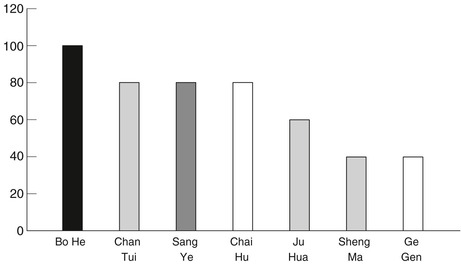 |
| Fig. 2.7. |
| Comparison of the light and dispersing features of the cold herbs. Bo He ( Menthae herba), Chan Tui ( Cicadae periostracum), Sang Ye ( Mori folium), Chai Hu ( Bupleuri radix), Ju Hua ( Chrysanthemi indici flos), Sheng Ma ( Cimicifugae rhizoma), Ge Gen ( Puerariae radix). |

